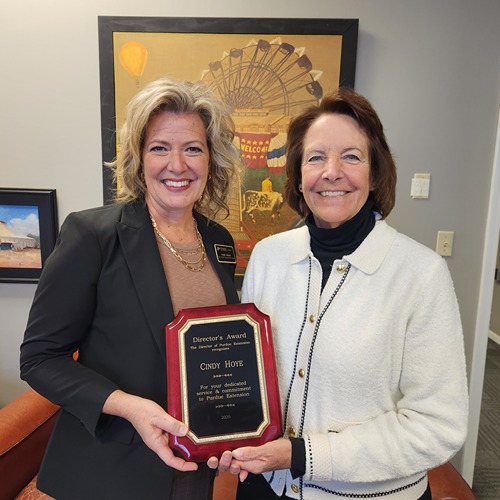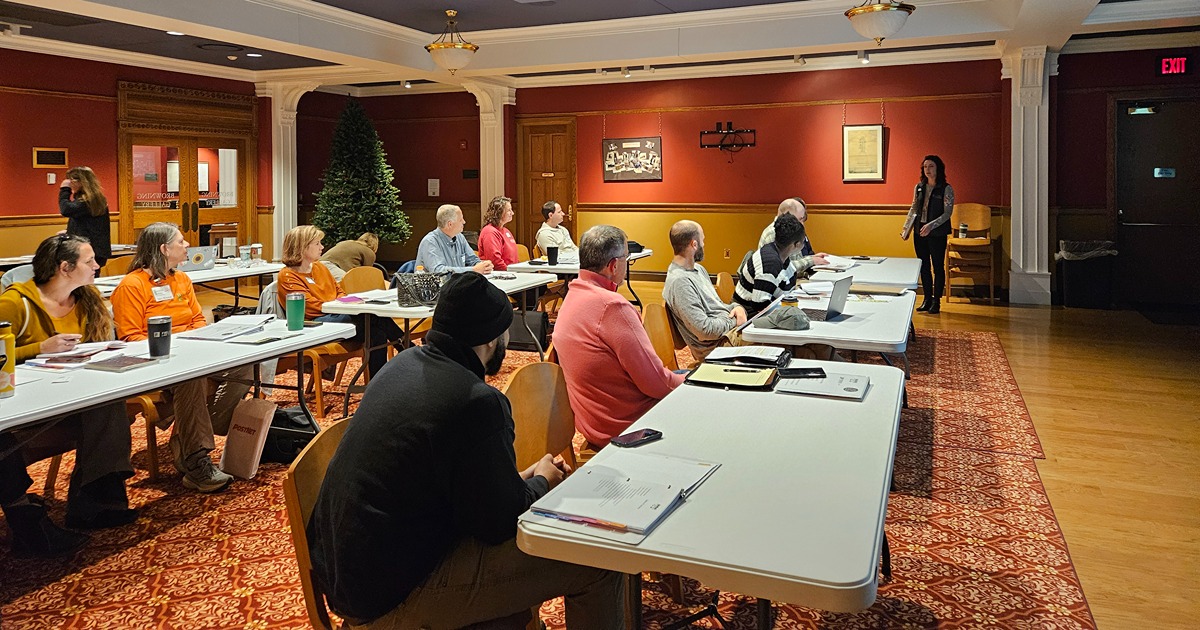Wells County
The Cooperative Extension Service is one of the nation's largest providers of scientific research-based information and education. It's a network of colleges, universities, and the U.S. Department of Agriculture, serving communities and counties across America. The Purdue University Cooperative Extension Service program areas are:
Agriculture and Natural Resources
Health and Human Sciences
Community Development
4-H Youth Development
Purdue Extension is a service tailored to meet the needs of Indiana, needs we know firsthand. Our educators, specialists, and volunteers live and work in all 92 Indiana counties. We provide the link between Land Grant research and Indiana citizens. In doing that we provide practical solutions to local issues. We provide information and expertise that's available in the form you want, when you want it. That's Purdue Extension, Indiana's home team advantage.
What We Do
We improve lives and livelihoods by delivering tested and trusted educational resources. The Cooperative Extension Service is one of the nation's largest providers of scientific research-based information and education. It's a network of colleges, universities, and the U.S. Department of Agriculture, serving communities and counties across America. The Purdue Extension focuses on: Agriculture and Natural Resources, Human and Health Sciences, Economic and Community Development and 4-H Youth.
Contact Us
2025 Wells County 4-H Rule Book
Check out the 2025 Wells County 4-H Rule Book for updated information about your 4-H projects.
2025 Wells County 4-H Rule BookServSafe Classes Offered
For more information and a list of available training's and exams in our area visit the Purdue ServSafe link below.
Learn More HereWells County Newsletters
Check out Health and Human Science Newsletters with helpful articles on health, nutrition, family and finances.
The November/December 2025 edition includes the following articles:
HOW TO HAVE HEALTHIER HOLIDAYS IN 1-2-3!
Stay Active
Even a few minutes of moderate-intensity physical activity can deliver some health benefits and count toward reaching the recommendations. For adults, the many benefits of physical activity include reduced short-term feelings of anxiety and better sleep.
Some tips for staying active during the holidays include:
- When shopping, walk a few laps around the shopping center before going into stores.
- Take the stairs at every opportunity. If you can't climb all the stairs, take the stairs part way, then the elevator.
- Rather than hunting for the closest parking spot, park farther away and walk briskly to your destination.
- When friends and family gather, go for a group walk. You can make the walk more fun by turning it into a scavenger hunt.
- Play an active group game in your yard or local park.
- Bundle up and take a walk instead of a drive to see holiday lights.
Eat Healthy
Eating well supports muscles and bones, boosts immunity, helps the digestive system, and aids in weight management, among other health benefits for children and adults. Good nutrition involves eating a variety of healthy foods. To do that during the holidays:
- If you eat foods that are high in calories, saturated fat, or added sugars, choose small portions and only eat them once in a while. Opt for healthier foods most of the time.
- At parties and other gatherings, fill your plate with your favorite fruits and vegetables first, then add small portions of less healthy items.
- If you are taking food to a party, make it your favorite healthy dish. Then you'll be sure that at least one item at the party will be a healthy choice that you enjoy.
- Make healthier versions of your traditional recipes by using ingredients with less fat and salt.
- Spice up baked fish or chicken by adding salsa or black bean sauce.
- Consider beans in place of higher-fat meats.
- Fill your plate with vegetables and lean protein.
Plan activities that don’t involve eating
Here are some ideas for shifting the focus away from food during the holiday season:
Volunteer in your community.
- Try a seasonal activity such as ice skating or winter hiking.
- Go on a walk and explore a new area with a friend or family member.
- Visit that museum or exhibit you've been wanting to see.
- Consider what new healthy traditions you can start this year. The possibilities are endless!
UPCOMING EVENTS
November 2025
10 Extension Homemakers Executive Committee - 2:00PM
10 Extension Homemakers Presidents Committee - 3:00PM
11 Veterans Days - Office Closed
19 ServSafe Training/Exam in Wells County
27-28 Office Closed - Thanksgiving
10 &17 “Where Does Your Money Go?”
25 & 12.2 “Where Does Your Money Go?”
December 2025
2 Extension Homemakers Holiday Luncheon
24 Christmas Eve - Office Closed
25 Christmas - Office Closed
January 2025
1 News Years Day - Office Closed
12 Extension Homemakers Executive Committee - 2:00PM
12 Extension Homemakers Presidents Committee - 3:00PM
19 MLK Jr. Day - Office Closed
Supporting Your Mental Health During the Holiday Season
By: Tanner Bommersbach, M.D., M.P.H., Policy Fellow, Center for Mental Health Services
In the 2003 holiday movie classic, “Elf,” the main character, Buddy, shares a particular fondness for the holiday season, “The best way to spread Christmas cheer is singing loud for all to hear!” No matter what traditions you celebrate this winter, not everyone shares Buddy’s enthusiasm for this season. While the holidays can be a time of celebration and joy for many, it also can be a period of stress, sadness, and loneliness for oth-ers—and sometimes can be particularly difficult for people living with mental health and sub-stance use conditions.
A survey* conducted by the National Alliance on Mental Illness (NAMI) found that 64 percent of individuals living with a mental illness report-ed that their conditions worsened around the holidays. Whether due to separation from loved ones, personal grief, the pressures of gift-giving, economic hardship, challenging interactions with family members, or shorter days, this time of year can bring unique behavioral health chal-lenges.
As we approach the holiday season, it is im-portant to remember that it is very common to feel added stress — and this stress can worsen symptoms of a mental health condition, such as depression or anxiety, or a substance use dis-order. However, there are ways to help address the stress or condition and improve your mental health. Below are strategies to help you find mo-ments of joy amidst the hustle and bustle this holiday season.
Strategies for supporting your mental health:
1. Pay attention to your feelings Remember that it is okay to feel unhappy during the holidays. Recognizing your feelings is the first step to ad-dressing and nurturing them.
2. Develop a plan for when you are feeling stressed, sad, or lonely This plan may include call-ing a friend or family member, going for a walk, engaging in an activity that brings joy, or watch-ing a favorite movie. Having a plan ahead of time can help ensure the difficult moments are more manageable.
3. Practice self-care It is important to schedule time for yourself and activities that recharge your mind and body. This may include reading a good book, working out, spending time in nature, and practicing stress management skills, such as deep breathing, meditation, and mindfulness. It is also important to remember to prioritize necessities, including eating a balanced diet, getting plenty of sleep, and finding time for exercise.
4. Connect with community If you can’t be near loved ones during the holidays, finding a sup-portive community through clubs, support groups, community centers, local meetups, and faith communities can help reduce feelings of loneliness and isolation. Consider scheduling a regular phone call with family and friends as well.
5. Support others During this time of year feel-ings of grief and loss can amplify. Check in on loved ones who may be alone or struggling dur-ing the holiday season. Helping a friend or neigh-bor not only gives joy to others, but it can im-prove your own happiness and well-being.
5. Support others During this time of year feel-ings of grief and loss can amplify. Check in on loved ones who may be alone or struggling dur-ing the holiday season. Helping a friend or neigh-bor not only gives joy to others, but it can im-prove your own happiness and well-being.
6. Recognize seasonal mood changes Sea-sonal Affective Disorder (SAD) is a condi-tion in which people experience symptoms of depression that are triggered by the change in seasons as the days get shorter. While this form of depression often im-proves in the spring and summer, it is im-portant to talk with your health care provid-er if you feel you are experiencing these symptoms. Treatment is effective and may include light therapy, antidepressant medi-cation, and/or talk therapy.
7. Avoid alcohol and drugs For people in recovery, the holiday season presents challenges that can trigger the use of alcohol and drugs. Having a plan for navigating social events and feelings of loneliness, can reduce the risk of sub-stance use. For family and friends, it is important to check in on those who may be struggling with substance use over the holidays.
Know when to seek help If you feel that your mental health struggles are becoming over-whelming and difficult to handle, it is important to seek help and know that treatment is availa-ble. Below are free and confidential resources that can connect you with effective treatment and support.
You are not alone. Here’s how to seek help.
SAMHSA’s National Helpline — 1-800-662-HELP (4357) - A confidential, free, 24-hour-a-day, 365-day-a-year, information service, in English and Spanish, for individuals and family members fac-ing mental and/or substance use disorders. This service provides referrals to local treatment facili-ties, support groups, and community-based or-ganizations.
988 Suicide & Crisis Lifeline — If you or someone you know needs support now, you can contact the 988 Suicide and Crisis Lifeline. Simply call or text 988 or chat 988lifeline.org.
Veterans Crisis Line — Reach caring, qualified re-sponders with the Department of Veterans Af-fairs. Many of them are Veterans themselves. Dial 988 then press 1.
Source: https://www.samhsa.gov/blog/supporting-your-mental-health-during-holiday-season
Where Does Your Money Go?
How you handle money impacts your financial stability. Join Molly Hoag, Health and Human Sciences Educator, to learn about smart money habits that help you stay in control of your finances.
YOU WILL LEARN SMART MONEY HAB-ITS LIKE:
- Keeping track of what you spend
- Finding where you’re spending too much
- Knowing the difference between what you need and what you want
- Setting clear financial goals in writing
- Making a plan to spend and save wisely
Workshops
1240 4-H Park Rd, Bluffton, IN 46714
Must Attend Both Dates
Must Attend Both Dates Per Class
Class A
Session 1 - November 10 @6:00PM
Session 2 - November 17 @6:00PM
Contact 260-824-6412 by Nov 5 to sign up
Class B
Session 1 - November 25 @6:00PM
Session 2 - December 2 @6:00PM
Contact 260-824-6412 by Nov 19 to sign up
PRESSURE CANNER TESTING
Pressure canner testing is now available again at the Wells County Extension Office.
Drop off your dial gauge pressure canner at the Extension Office M-F, 8AM—4:30 PM. We will call you to pick it up once it’s been tested.
Brands we test: Presto, National, Magic Seal, Maid of Honor
Canners can be dropped off at the Wells County Community Center,
1240 4-H Park Road, Bluffton.
Cost for the inspection is $5.00.
Extension Homemakers Holiday Luncheon
12/2/25
11:00AM
Details to follow.
News Notes for Parents is a newsletter geared towards parents with children ages 8 and under. You will find articles about parenting, early childhood education, nutrition and much more.
In the October 2025 issue of News Notes for Parents, you will find the following articles:
Pumpkins– From Decoration to Delectable!
Once autumn rolls in, pumpkins flourish. They are used to decorate porches, flavor baked goods and coffee drinks, and star in fall festivals across the country. Many of you may have already been taking advantage of the fall/winter squash selections in stores and from local growers. You may also be reading this thinking, I’m passed pumpkin and moving on to peppermint and gingerbread but with Thanksgiving tomorrow, pumpkins still have time to be featured! They come in all shapes and colors, varying from short and stout, oblong, tall and narrow, green, orange, yellow, white, and purple. Pumpkins offer many nutrients and health benefits in addition to their fall décor qualities.
Squash that is harvested in the fall is known as winter squash. Each type of winter squash differs in color, shape, size, and flavor but all have thicker shells than summer squash. These thick shells can be more of a challenge to work with but are what make these squash shelf-stable for a few months when kept in proper conditions.
Choose a firm, well-shaped squash that feels heavy for its size. They should have hard, tough skin without soft spots or areas that have sunken in. Store pumpkins in a cool, dry place to keep them shelf-stable for several months. Many varieties can be baked, boiled, steamed, cooked in an electric pressure cooker, and even roasted in an air fryer. Be sure to first rinse the squash under running water prior to peeling or cutting through the skin. Depending on what you plan to do with the pumpkin will determine whether you peel it before or after cooking methods. When steaming, the peel should be removed prior to cooking. If baking, there is no need to peel prior to the baking process. Simply remove the ends, cut the squash in half, remove the seeds, and bake as squash halves.
These delectable and colorful decorations are a great source of vitamin A, vitamin C, and potassium.
These nutrients are important for nerve impulses, skin formation, healthy bone maintenance, and contribute to our eye health. They also provide us with antioxidants that we know work to keep the good stuff in our bodies and shuffle the bad things out.
Pumpkins are over 90% water and all parts of the pumpkin are edible. You can eat the skin, leaves, flowers, pulp, seeds, and even the stem… if you so choose. The flesh of the pumpkin is what we eat most frequently and what is incorporated into baked goods. Pumpkin puree can help stretch your next pot of chili a little farther or add flavor to your next bowl of oatmeal. Seeds of the pumpkins can be roasted or baked for a crunchy snack, mixed with oats as a granola base, or sprinkled over a bowl of soup. Try tossing the seeds in olive oil and cinnamon for a sweeter snack or oil and chili powder for a savory snack. Separate the seeds from the pulp and lay them in a single layer on a cookie sheet. Bake at a low temperature of about 170°F for 15-20 minutes and enjoy!
Jessica Riffle, HHS Educator
Purdue Extension – Fulton County
Building connections with friends
Having healthy relationships with the kids in our lives is one the of the best ways to support and protect their mental health. A healthy connection parent-child relationship not only helps children bounce back from life’s difficult moments, but it also helps children handle big emotions, reduce negative behaviors, boost their attention spans, increase their sense of belonging and build social skills.
Building a healthy connection with your child starts the moment they’re born. The way we interact with them, the way we respond to their behaviors and the way we handle our own stress are all important. We have some resources to help get you started:
Intentional Child Time: Parenting is hard and your time is limited. What if we told you there are recommendations of things you can do when spending time with your child that research has shown builds healthy relationships and improves child behavior? The best part is that it only takes a few minutes a day!
Conversations: Our children want to feel like they’re important and heard. This is why we recommend daily check-ins with your children. Conversations about topics big or small build closeness in the parent-child relationship, help you get to know your child, and help children feel comfortable coming to you when they’re in need.
Routines: Creating a daily schedule and routine for children can often feel like a magic wand when it comes to building positive behaviors. This is because when kids know what to expect out of their day, they feel more in control. Additionally, power battles decrease because they start building habits.
Responding to difficult behaviors: How we treat our kids when they misbehave is just as important as how we spend fun time with them. While our job as parents is to guide their behavior, we also want to make sure we respond in a way that does not harm the relationship.
Take care of you: Parenting can be hard because we are humans too. We feel strong emotions just like our children and on hard days, it is really difficult to show up as our best selves and parent. Taking care of yourself will help you be more effective at connecting with your kids.
You can start improving your relationship with your child today. Select one or two steps that you feel most comfortable with. Over time, expand to more of them. As you try more elements, you will gain confidence and be ready to do even more.
Source: https://www.kidsmentalhealthfoundation.org/mental-health-resources/mental-wellness/building-connections-with-kids
PARENT TIP: Check out these great conversation starters found on kidsmentalhealthfoundation.org
Molly Hoag, Health & Human Sciences Educator www.extension.purdue.edu/wells
News Notes To Parents is a product of Purdue Extension—Wells County. If you have comments or need information,
call (260) 824-6412 The office is located at 1240 4-H Park Road, Bluffton, IN 46714 Tell someone about us!
Purdue University prohibits discrimination against any member of the University community on the basis of race, religion,
color, sex, age, national origin or ancestry, genetic information, marital status, parental status, sexual orientation, gender
identity and expression, disability, or status as a veteran.
Wells County 4-H Newsletter
September/October
2026 Enrollment
Enrollment for the 2025-2026 program year begins Wednesday,
October 1st! This enrollment period applies to all 4-H participants
including Mini 4-H (grades K-2), traditional 4-H members (grades
3-12), and all adult volunteers. Brief instructions are listed below,
but a detailed version will be sent in the mail and is available
online at www.extension.purdue.edu/wells
ENROLLMENT INSTRUCTIONS:
- Go to https://v2.4honline.com
2. Enter your email and password, then click “Sign In”. Do not
create a new account. If you have forgotten your
username/password please call the Extension Office.
3. Continue to Youth & Mini 4-H Member Enrollment
4. Select the member you wish to enroll and update grade level.
5. Continue on to “Select Club”, then “Select Projects”
6. Once complete, click “Select Questions” and fill out correctly.
7. Pay member dues. Enrollments will not be approved until
payment is complete.
2026 WELLS COUNTY 4-H FAIR
Saturday, July 11th - Thursday July 16th
September
September 1: Labor Day - Extension Office Closed
September 8: Association Meeting, 7:00PM, Meeting Rooms
September 10: Project Round Tables, 6:30PM
September 22: Council Meeting (1st Rule Change Review), 7:00PM, Meeting Rooms
September 16-20: Bluffton Street Fair
September 27: Jr Leader Officer Training
September 28: Horse & Pony Banquet (5:30PM) and Fun Show, 2:00PM, Grandstand
Arena
October
October 1: Enrollment Opens for the 2026 Wells County 4-H Fair
October 13: Columbus Day - Extension Office Closed
October 13: Association Meeting, 7:00PM, Meeting Rooms
October 25: Wells County 4-H Association Spooktacular, 6:00-9:00PM, 4-H Park
November
November 10: Club Leader Meeting, 6:00PM, Meeting Rooms
November 10: Council Second Rule Change Meeting and Elections, 7:00PM, Meeting
Rooms
November 17: Association Meeting, 7:00PM, Meeting Rooms *Elections*
Adult Volunteer
Enrollment
Adult volunteers must re-enroll in 4-H Online to be a volunteer for the 2025-2026 year. This means completing all of the volunteer training. It does have to be done each year. Any new volunteers will also need to complete the enrollment process.
To enroll, log in to your 4-H Online account. Enrollment begins October 1st
Returning members will choose “Adult Enrollment”, and new members should click “Adding New Members”. You will then follow the instructions until enrollment is complete, making sure to watch all the video trainings.
4-H Benefit Auction
January 23, 2026
As a big look ahead, we want to keep in everyone's mind the 2026 Wells County 4-H Benefit Auction.
Come be part of a night full of community spirit, delicious food, and an exciting auction. It’s a wonderful way to support youth development and the continued growth of the Wells County 4-H Park.
Meal 5:00PM-7:00PM
Silent Auction 5:00PM-6:30PM
Special Features start at 6:00PM
Live Auction starts at 7:00PM
Pick Up Projects:
The Extension Office is currently housing
SEVERAL county and state fair projects that need to be reunited with their rightful owner. Although we have enjoyed their company, it is time for them to make their way back to their forever home. If you are missing a project from either the county or state fair, more than likely we have it! Please come pick it up ASAP from the office.
Our office hours are Monday - Friday from 8:00AM-4:30PM. If you are unable to come during those hours please call 260-824-6412 to make other arrangements. Your projects miss you and want to come home!
Cash Your Checks!
This is a reminder to all 4-H Auction Participants that your checks from the auction should be cashed by November 30th or funds will be forfeited. If you have yet to pick up your check, please do so ASAP!
Make sure to bring in your thank you cards addressed, stamped & sealed. Checks will not be handed out until thank you cards have been turned in.
Wells County 4-H Association Spooktacular
October 25, 2025
from 6:00-9:00PM
Wells County 4-H Park
Volunteers Needed: Please look out for
sign-up sheet to come
More information To come : info will be posted on Facebook and flyer will be sent out
Spooktacular Volunteers:
The Wells County 4-H Association is hosting their Spooktacular festival again this year! Check out page 6 for date and details. They are looking for adult and youth volunteers to help with the carnival games, concessions, and the spooky forest. If you are interested in helping out please contact Brandon at 765-499-7042 or Janet at 260-273-1123.
Pancake Booth Sign Up:
4-H Pancake Booth will once again be at the Bluffton Street Fair this year! The Booth is a great fundraiser for 4-H, as these funds help sponsor our ribbons at the Fair and various 4-H Trips that our youth get to attend.
Volunteers are needed for various shifts throughout the week. Each township is responsible for finding 12-16 people to work during their assigned shift.
Volunteers will be cooking food, taking orders, and help deliver food to guests. It really does take several people to run the booth smoothly. Shift days are listed below. Sign up online at:
https://bit.ly/PancakeBooth2024
TUESDAY, SEPT. 16TH 5PM TO CLOSE
Liberty Township
WEDNESDAY, SEPT. 17TH 7AM - 5PM
Community Volunteers
WEDNESDAY, SEPT. 17TH 4:30PM TO CLOSE
Chester Township
THURSDAY, SEPT. 18TH 7AM - 5PM
Community Volunteers
THURSDAY, SEPT. 18TH 4:30PM TO CLOSE
Jefferson Township
FRIDAY, SEPT. 19TH 7AM - 5PM
Jackson Township & Shooting Sports
FRIDAY, SEPT. 19TH 4:30 TO CLOSE
Nottingham Township
SATURDAY, SEPT. 20TH 7AM - 12PM
Rockcreek Township
SATURDAY, SEPT. 20TH 11:30AM - 5PM
Lancaster Township
SATURDAY, SEPT. 20TH 4:30PM TO CLOSE
Harrison Township









